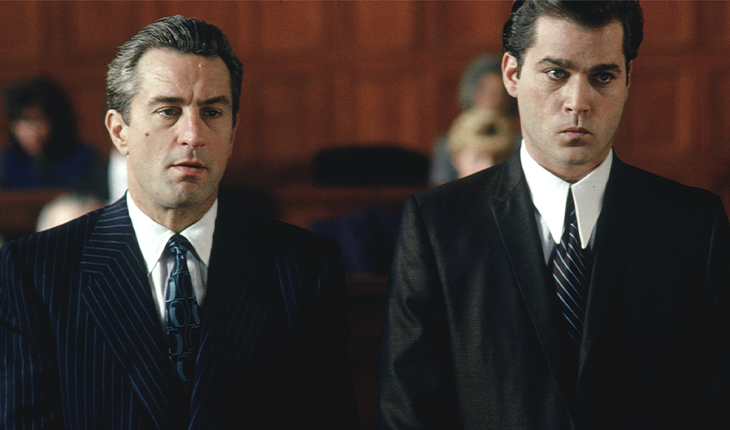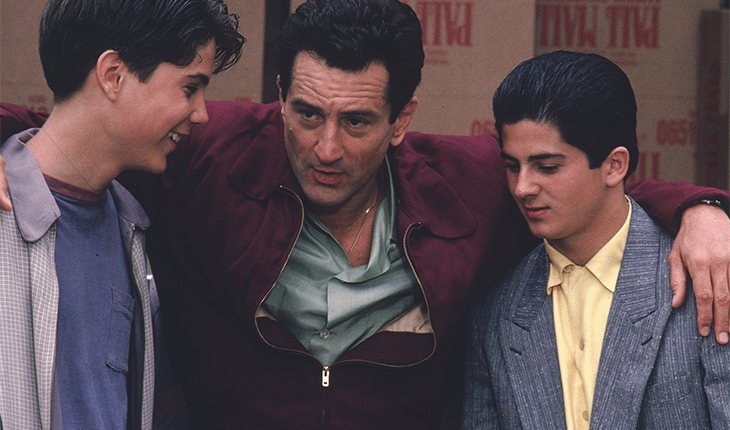March Film Club: Goodfellas
Scorsese is known for large scale narratives following the protagonist’s rise, and eventual fall, in a world powered by ill gotten gains. But this wasn’t always the case. Throughout the '70s and '80s Scorsese mainly focussed on more intimate stories. They were smaller in scale, with less characters, lower stakes, and less of the excess and slickness we’ve come to expect from him. But all of this changed in 1990, with the release of perhaps his magnum opus, Goodfellas.

We open with our three central characters - played with pitch perfect casting by Ray Liotta, and Scorsese regulars Robert De Niro and Joe Pesci - driving in a car at night. They hear some strange noises, they pull over and open up the boot to reveal a bloodied body, barely alive. After De Niro and Pesci finish him off the camera pushes into a close up of our protagonist Henry Hill (Liotta), and we hear the now iconic line - "as far back as I can remember I always wanted to be a gangster" - followed by Tony Bennett’s Rags to Riches.
With this opening Scorsese announced this new version of himself to the world. Goodfellas isn’t an intimate, gritty, story of a single character, but a slicker, more charismatic and exuberant film. The red neon glow from the back lights of the car, the smooth push into Liotta’s close up, and a needle drop that could’ve been specifically grown in a lab exactly for this film, made a new approach clear from the first two minutes.
Goodfellas is truly a story of a man’s life, from his start in the gangster world running errands for local mafia don Paulie. He soon meets Jimmy and Tommy (De Niro and Pesci) and together they gradually work their way up in the crime world. Extortion, carjacking, cargo theft, arson, drug dealing. This is what makes the world go round for your average ‘wiseguy’. All done in iconic silk shirts, wide cars, and gold jewellery. In a move typical from the era of Scorsese’s career that Goodfellas began, it’s easy to fall for the allure and luxury allowed by a life of crime.

Of course, they have all the money they could ever need, but more than this they have all the respect they could ever want. Exemplified by the famous long take, starting outside the Copacabana club, following Henry and his partner through a private entrance, through the kitchen, onto the club floor and to their table. All the way they are greeted by staff and fellow gangsters, all paying respect to the then 21 year old rising star in the mafia world.
But Goodfellas is not only about the rise of Henry Hill, but the fall too. And after an hour and a half of this ecstatic mafia life, things start to go downhill. Loyalties are tested, the consequences of past mistakes come back with a vengeance, and what was once a massive money maker for Henry begins to show its adverse effects - cocaine.
This comedown is showcased in an impressive ten minute sequence towards the end of the film. Henry has a busy day; he has to deliver some illegal guns to Jimmy, pick up his brother from the hospital, deliver some drugs, prepare for another drug deal, and cook Sunday dinner for his family. This frantic, paranoid, sequence is a tour de force of Scorsese’s directing prowess, with the pace never letting up and Henry’s anxiety practically seeping out of the screen. One minute he’s screwing a silencer onto a gun, the next he’s perfecting the tomato sauce, all between sniffing lines of cocaine with a helicopter overhead fuelling a kind of manic paranoia. This sequence is when Scorsese truly allows the audience to feel the reality of this kind of life. It might be luxurious and exciting at the start, but it never ends well.

Goodfellas is what happens when you take a director at the peak of his powers, supply him with a cast seemingly sent from God to be in this film, all supported by long time editor Thelma Schoonmaker who constricts a story of epic scale into an extremely tight two hours twenty. Based on the book Wiseguy by Nicholas Pileggi (who has penned the upcoming De Niro vehicle Alto Knights, heading to cinemas on March 21), Goodfellas is one of the best depictions of mafia life ever put to screen.The costumes, the music, the voice over, everything comes together in a cinematic symphony of cars, guns and gangsters. It’s as close to a perfect film there can be.
Watch here.